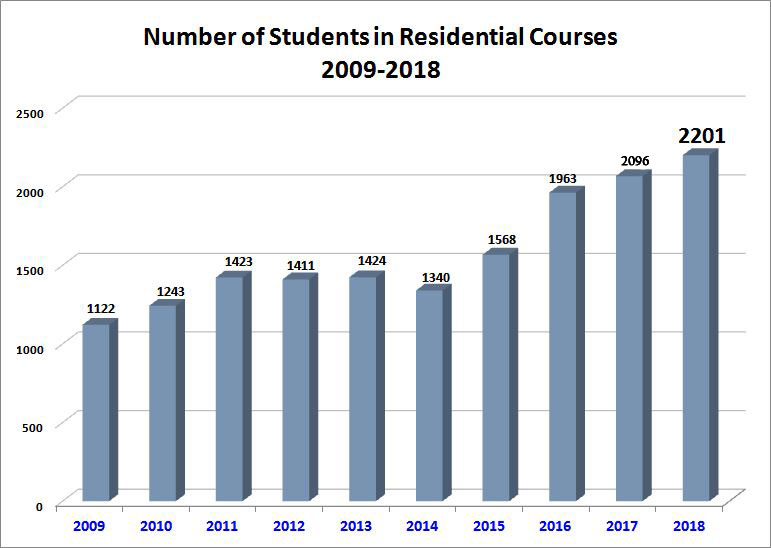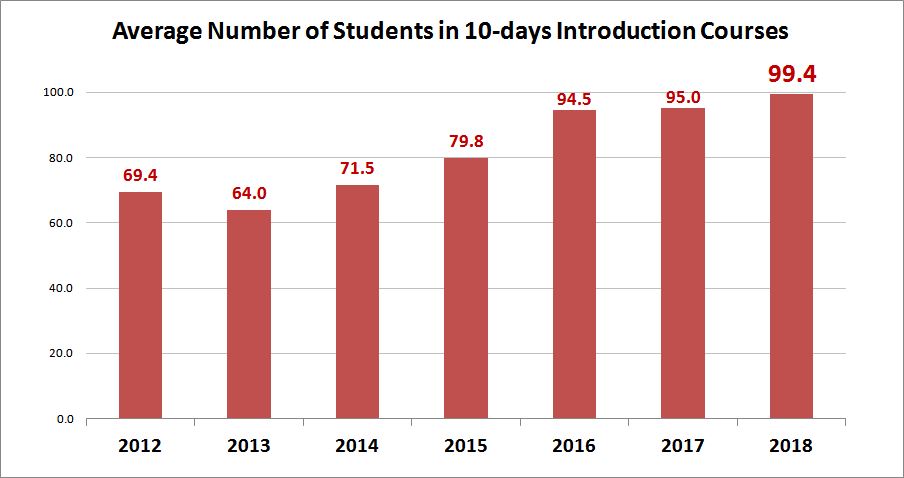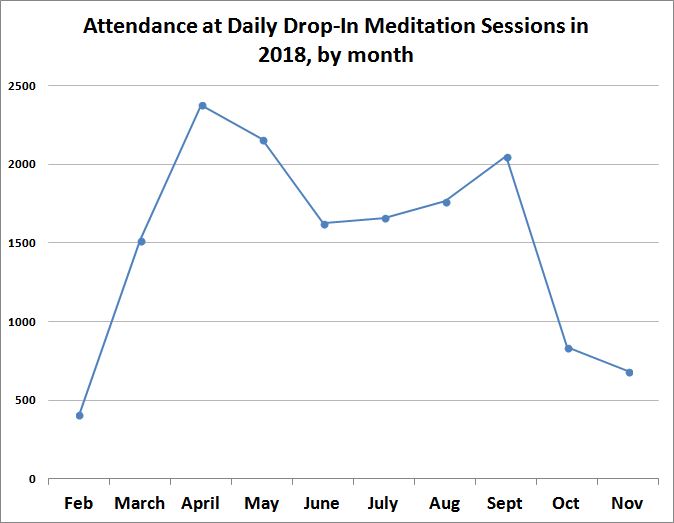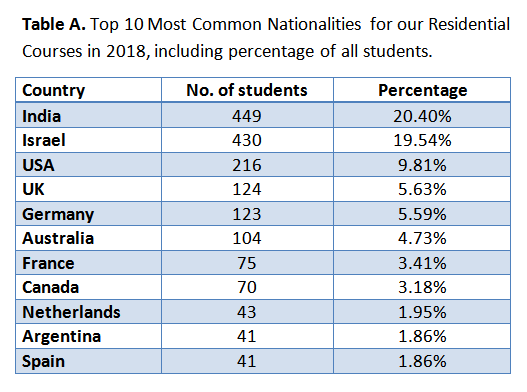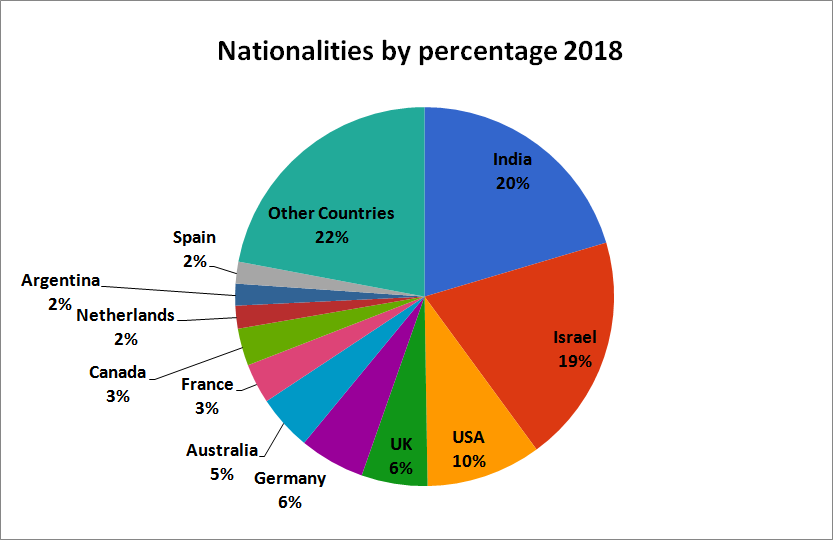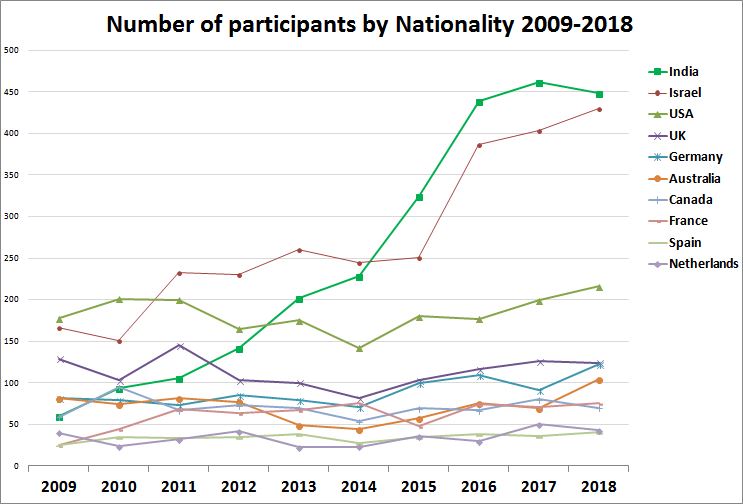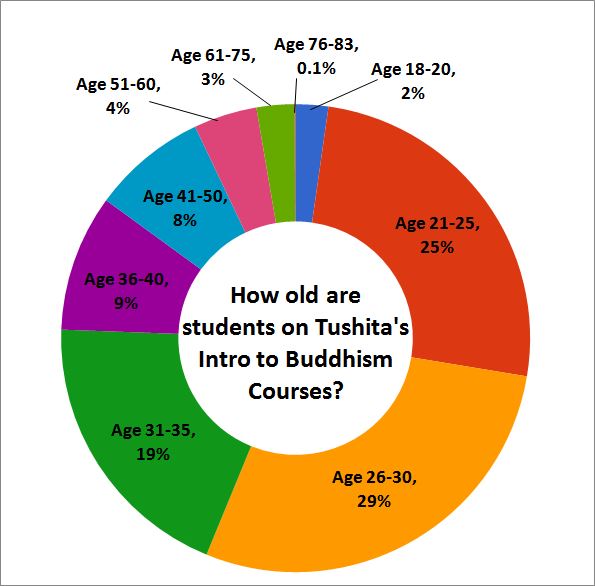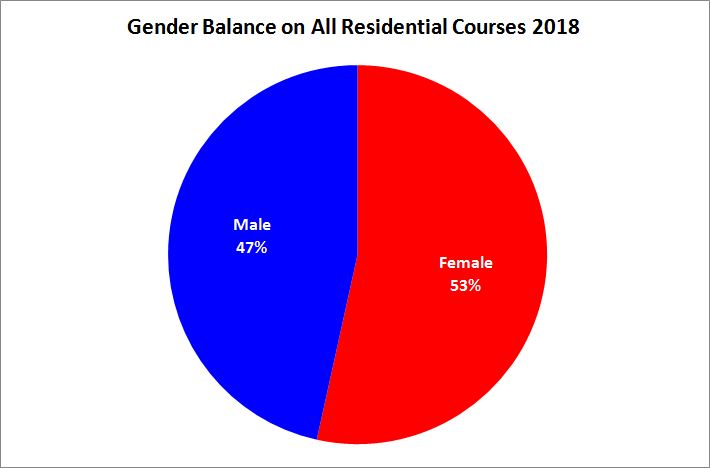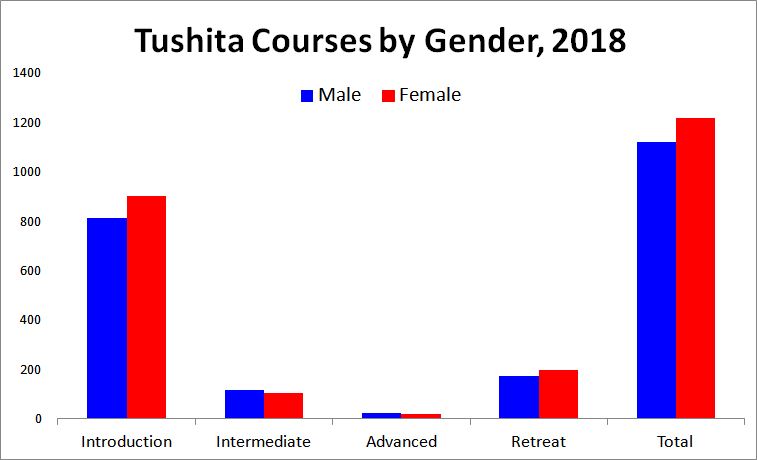- Home
- About Us
- Programs
- Being Here
- FAQs
- Resources
- News
- Links
- Support Us
Dec

Each year as we complete the season, we are eager to crunch the numbers to see how our experience of success translates into numbers and graphs. Our 2018 season running from February to November has proven once again that interest in Tibetan Buddhism continues to grow, as does our ability to meet it! (See Figure 1.)
Figure 1. Total residential course attendance each year from 2009 to 2018.
As Table A. displays, this year we hosted 16 Introduction to Buddhism courses, a special introductory-level course with Geshe Lhakdor, 8 intermediate/advanced courses, 7 group retreats, and our annual Pre-ordination course!
All these residential courses and retreats were attended by 2,201 students – a new Tushita record!! ???
This was made possible by our increasingly effective determination to get as many students who wish to meet the Dharma into our courses.
Again, most of our courses had long waiting lists and once more our most numerous student nationality was India.
The increased interest of students combined with our determination to accommodate them resulted in our highest average yet for our Introduction Course attendance: 99.4 students per course!
You can see the growth progression of these popular courses over the past seven years in Figure 2 below.
This year we supplemented our schedule with an additional 10 short courses. These were non-residential courses from 2 – 4 days in duration which attracted a total of 840 participants! With such a response we are encouraged to host more next year to meet the interest.
Our daily drop-in meditations continued to be a huge hit with visitors this year. (See Figure 3 below). Our very conservative estimate of total attendance for 2018 is 15,079! This number is lower than last year due in part to our many short courses and running three simultaneous residential courses (during which time we suspended morning meditations- time to build a fourth gompa!), as well as several public audiences with His Holiness, and our admittedly incomplete record-keeping for morning attendance. Whatever the actual total number was, the sessions themselves were seen as a success, and the gompa was regularly filled to the brim. We even had to set up a speaker so that those who could only find seating outside the meditation hall could still participate! Our highest single day attendance was May 8th with 150 visiting meditators! We rejoice.
In addition to these regular offerings, we welcomed uncounted visitors to our many special guest teachings throughout the year such as His Eminence Ling Rinpoche’s second initiation in as many years at Tushita. This year His Eminence offered the White-Tara Long Life initiation which was a tremendous success. To see the beautiful photos from this and all our other amazing special events, please see our December 2018 Newsletter.
But who are these people who come on Tushita courses?
Who are our Indian Students?
We are so happy to welcome so many Indian students to our courses. Over the last 10 years the interest in Buddhism by Indians has increased tremendously. The graph below demonstrates this steady growth in interest.
The majority of our Indian students are young adults, with 50% between the ages of 26 and 35. This suggests to us that more Indians today are taking time at an earlier age (rather than waiting until their later years) to explore their spirituality. We rejoice in this new prioritization as we believe the fruits of these internal efforts will improve the quality of all their subsequent years.
As the pie chart below reveals, almost 2/3 of our Indian students are male. Women gained a little more ground this year compared to last: a 2% increase.
The graph below shows the gender balance of our top ten nationalities in 2018. Interestingly, we have more female students compared to male among every country with the sole exception of India. We hope to welcome ever-more Indian women and men in the years to come!
Where are Tushita’s Students from?
As of 2018 we have now had students in our residential courses from 99 different countries! This year we were happy to welcome students from Montenegro and the United Arab Emirates for the first time!
In Table A you can see a list of the top ten nationalities represented in our residential courses in 2018. (Figure 3 below shows these countries highlighted on a world map.)
If you would like to see the full list of 99 countries, please click here. See if your country is represented. If not: come, we need you!
This year Canada and Australia swapped places from last year at #6 and #8. Spain – not one to stand around and be kicked off the Top Ten list for long (2017) – made a comeback tying for 10th place with a brand new contender: Argentina! This is the first time Argentina has appeared on our Top Ten, jumping from 15th place last year. Brazil did not see this coming, and was short by just two students for a shared spot at #10.
Figure 2 (below) gives historical perspective by showing national trends. One of the most significant changes we’ve noticed over the past 10 years is the shift in national patterns of participation, primarily – The Rise of India! This year, with a slight reduction in Indian attendance combined with a record-breaking number of Israeli students, Israel is giving India a run for the title once more! Last year India had a lead of 58 students over Israel; this year there was a difference of only 19!
Will Israel playfully wrest it’s Tushita crown back from India in 2019? Come join us and find out!
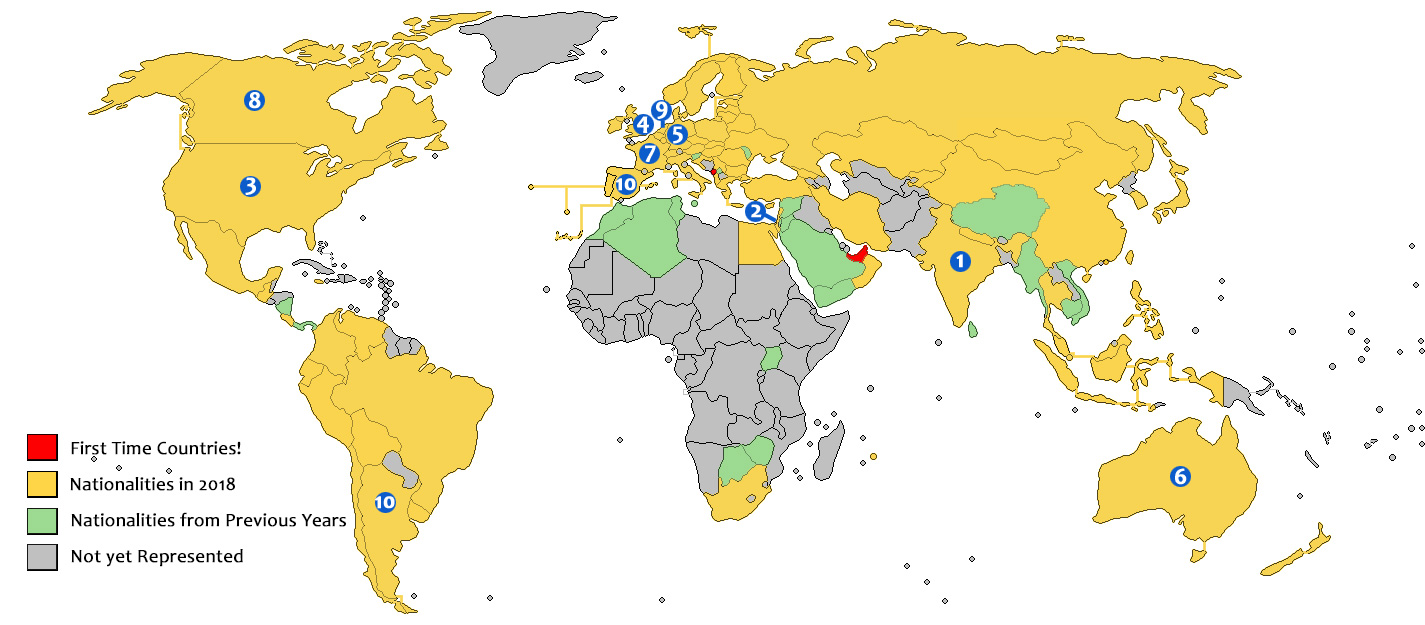
Figure 3. World Map highlighting countries from which we had students for the first time this year (red), all countries represented in 2018 (yellow), previously represented nationalities who were not present this year (green), and countries from which we have not yet had a student (grey). Numbers indicate this year’s Top Ten Nationalities represented. If your country is in Grey, please come!
As you can see from the graph below, more than half of our Introduction to Buddhism course students are in their 20’s. What’s interesting to note is that our student demographic has slightly matured this year. The ring chart below shows that 56% of students were aged 18 – 30 (compared to 59% last year), 28% aged 31 – 40 (up 1%), and 15% were over 40 (also up 1%). While the majority of students in Introductory courses are under 30, in our Intermediate courses there is a much more even spread of ages. We don’t have the same predominance of students in their twenties in our Intermediate courses that we do in our Introductory courses; instead Intermediate course students are primarily in their thirties. This is evidenced in the graph below showing the age range of Intermediate course students (green) against that of the Introductory course students (red). Figure 2. Spectrum of student ages in Introduction courses overlaid by those of Intermediate course students in 2018. Over the 10 years we’ve been studying our records, the gender balance of students has remained surprisingly stable, with always 5-10% more women than men taking part. The exact same ration of men to women have participated in our courses this year compared to last year. The graph below depicts the breakdown of gender by course types in 2018. Usually we have slightly more females than males in all of our courses, but this year we actually had slightly more males than females in both our Intermediate and Advanced courses.
Click here to see the full list of countries in 2018!
#
Citizenship of
Residential Course Students2018
% From 2009-2018
1
India
449
20.40%
2
Israel
430
19.54%
3
USA
216
9.81%
4
UK
124
5.63%
5
Germany
123
5.59%
6
Australia
104
4.73%
7
France
75
3.41%
8
Canada
70
3.18%
9
Netherlands
43
1.95%
10
Spain
41
1.86%
11
Argentina
41
1.86%
12
Brazil
39
1.77%
13
Italy
35
1.59%
14
Russia
31
1.41%
15
Mexico
30
1.36%
16
Switzerland
29
1.32%
17
New Zealand
23
1.04%
18
Austria
21
0.95%
19
Colombia
19
0.86%
20
Sweden
17
0.77%
21
Ireland
17
0.77%
22
Poland
16
0.73%
23
Chile
15
0.68%
24
Belgium
14
0.64%
25
Denmark
12
0.55%
26
South Africa
12
0.55%
27
Japan
12
0.55%
28
Thailand
11
0.50%
29
South Korea
10
0.45%
30
Singapore
10
0.45%
31
China
8
0.36%
32
Portugal
7
0.32%
33
Turkey
7
0.32%
34
Czech Republic
7
0.32%
35
Slovakia
6
0.27%
36
Kyrgyzstan
4
0.18%
37
Finland
3
0.14%
38
Norway
3
0.14%
39
Ukraine
3
0.14%
40
Malaysia
3
0.14%
41
Bulgaria
3
0.14%
42
Indonesia
3
0.14%
43
Iran
3
0.14%
44
Luxembourg
3
0.14%
45
Egypt
3
0.14%
46
Guatemala
3
0.14%
47
Mongolia
3
0.14%
48
Romania
2
0.09%
49
Hungary
2
0.09%
50
Lithuania
2
0.09%
51
Peru
2
0.09%
52
Belarus
2
0.09%
53
Nepal
2
0.09%
54
Ecuador
2
0.09%
55
Serbia
2
0.09%
56
Kazakhstan
2
0.09%
57
Cyprus
2
0.09%
58
Albania
2
0.09%
59
Taiwan
1
0.05%
60
Estonia
1
0.05%
61
Greece
1
0.05%
62
Latvia
1
0.05%
63
Mauritius
1
0.05%
64
Venezuela
1
0.05%
65
Croatia
1
0.05%
66
Uruguay
1
0.05%
67
Costa Rica
1
0.05%
68
Philippines
1
0.05%
69
Lebanon
1
0.05%
70
Oman
1
0.05%
71
Georgia
1
0.05%
72
Jamaica
1
0.05%
73
Bolivia
1
0.05%
74
Hong Kong
1
0.05%
75
Montenegro
1
0.05%
76
UAE
1
0.05%
2201
100.00%
#
Citizenship of
Residential Course Students2009
2010
2011
2012
2013
2014
2015
2016
2017
2018
Total 2009-2018
% From 2009-2018
1
Israel
166
151
233
230
260
245
251
387
404
430
2757
17.49%
2
India
60
94
106
142
202
228
325
439
462
449
2507
15.90%
3
USA
178
201
200
165
175
142
180
177
199
216
1833
11.63%
4
UK
129
103
145
103
100
81
103
116
126
124
1130
7.17%
5
Germany
82
79
73
85
79
71
100
109
91
123
892
5.66%
6
Australia
81
74
81
77
49
44
57
75
69
104
711
4.51%
7
Canada
59
95
67
73
69
54
69
67
80
70
703
4.46%
8
France
25
44
68
63
67
76
48
74
71
75
611
3.88%
9
Spain
25
35
33
35
38
27
35
38
36
41
343
2.18%
10
Netherlands
40
24
32
42
22
23
36
30
50
43
342
2.17%
11
Brazil
10
18
15
25
15
26
24
33
40
39
245
1.55%
12
Sweden
13
25
26
35
34
18
16
29
29
17
242
1.54%
13
Italy
14
16
14
17
22
13
23
32
35
35
221
1.40%
14
Austria
12
18
27
31
16
10
25
19
29
21
208
1.32%
15
Mexico
17
21
19
24
14
10
9
23
21
30
188
1.19%
16
Argentina
7
8
14
17
14
19
20
25
23
41
188
1.19%
17
Switzerland
15
26
14
28
15
15
8
13
21
29
184
1.17%
18
Russia
8
2
7
9
26
26
26
27
20
31
182
1.15%
19
Ireland
19
16
22
16
14
15
10
20
19
17
168
1.07%
20
New Zealand
18
20
12
6
11
8
11
16
19
23
144
0.91%
21
Belgium
11
9
9
17
9
16
18
13
16
14
132
0.84%
22
Poland
6
9
9
9
10
19
11
18
15
16
122
0.77%
23
Chile
1
10
12
3
12
8
13
21
21
15
116
0.74%
24
Denmark
15
10
16
13
10
8
7
6
14
12
111
0.70%
25
Colombia
2
8
7
7
7
13
13
13
13
19
102
0.65%
26
Finland
14
6
18
9
11
6
9
14
10
3
100
0.63%
27
South Africa
9
4
5
7
12
9
14
14
9
12
95
0.60%
28
South Korea
9
7
12
20
12
6
3
9
6
10
94
0.60%
29
Portugal
6
1
15
9
15
3
6
11
13
7
86
0.55%
30
Japan
11
6
11
8
11
4
5
4
6
12
78
0.49%
31
Turkey
3
6
5
5
2
6
5
6
14
7
59
0.37%
32
Singapore
2
10
7
7
1
1
7
1
6
10
52
0.33%
33
Czech Republic
4
2
7
6
5
7
3
3
7
7
51
0.32%
34
Taiwan
4
16
1
3
7
3
6
0
1
1
42
0.27%
35
Slovenia
5
1
2
8
4
9
9
3
0
0
41
0.26%
36
Norway
2
5
2
8
6
2
3
5
5
3
41
0.26%
37
Romania
1
3
2
2
5
6
5
5
9
2
40
0.25%
38
Ukraine
2
5
3
3
6
7
2
6
2
3
39
0.25%
39
China
1
2
3
4
5
4
4
1
4
8
36
0.23%
40
Hungary
2
6
2
3
4
6
3
3
2
2
33
0.21%
41
Slovakia
3
7
5
0
0
5
3
3
1
6
33
0.21%
42
Thailand
0
1
5
0
2
2
6
1
1
11
29
0.18%
43
Estonia
5
1
10
2
1
1
2
4
1
1
28
0.18%
44
Vietnam
6
0
1
3
3
3
0
3
8
0
27
0.17%
45
Greece
5
4
1
3
1
5
3
2
0
1
25
0.16%
46
Tibet
3
5
4
0
6
1
2
1
3
0
25
0.16%
47
Malaysia
1
8
1
4
0
1
3
3
0
3
24
0.15%
48
Bulgaria
0
0
2
0
3
2
3
5
4
3
22
0.14%
49
Lithuania
1
0
2
5
0
2
4
3
2
2
21
0.13%
50
Indonesia
0
5
10
0
0
1
1
0
1
3
21
0.13%
51
Latvia
1
1
5
2
1
1
0
2
2
1
16
0.10%
52
Mauritius
0
2
1
1
1
3
1
2
4
1
16
0.10%
53
Iran
0
1
3
0
0
0
2
3
1
3
13
0.08%
54
Peru
0
2
0
1
0
1
1
0
4
2
11
0.07%
55
Luxembourg
4
0
1
2
0
0
0
0
0
3
10
0.06%
56
Malta
1
0
2
1
1
2
1
0
1
0
9
0.06%
57
Belarus
0
0
1
1
2
1
2
0
0
2
9
0.06%
58
Venezuela
1
1
1
1
0
3
0
0
1
1
9
0.06%
59
Croatia
0
0
0
0
0
0
1
5
2
1
9
0.06%
60
Uruguay
0
1
0
0
1
1
0
2
2
1
8
0.05%
61
Nepal
1
1
0
2
1
0
0
0
1
2
8
0.05%
62
Costa Rica
0
0
0
0
0
0
1
4
1
1
7
0.04%
63
Philippines
0
0
1
0
0
1
2
1
1
1
7
0.04%
64
Ecuador
0
0
1
3
0
0
1
0
0
2
7
0.04%
65
Egypt
0
0
0
1
0
2
1
0
0
3
7
0.04%
66
Kyrgyzstan
0
0
1
1
0
0
0
1
0
4
7
0.04%
67
Serbia
0
0
1
0
0
0
0
1
3
2
7
0.04%
68
Guatemala
0
0
0
0
0
1
1
0
2
3
7
0.04%
69
Kazakhstan
0
0
0
0
0
0
1
3
0
2
6
0.04%
70
Cyprus
0
3
0
0
1
0
0
0
0
2
6
0.04%
71
Iceland
0
1
0
1
0
1
0
2
0
0
5
0.03%
72
Lebanon
0
0
0
1
0
0
0
3
0
1
5
0.03%
73
Mongolia
0
0
0
0
2
0
0
0
0
3
5
0.03%
74
Morocco
0
1
0
0
1
1
0
0
1
0
4
0.03%
75
Oman
0
0
0
1
1
0
0
0
1
1
4
0.03%
76
Jordan
0
0
0
0
0
1
1
1
0
0
3
0.02%
77
Georgia
1
0
1
0
0
0
0
0
0
1
3
0.02%
78
Jamaica
0
0
2
0
0
0
0
0
0
1
3
0.02%
79
Bolivia
0
0
0
0
0
0
0
2
0
1
3
0.02%
80
Albania
0
0
0
0
0
0
0
0
1
2
3
0.02%
81
Sri Lanka
0
0
1
0
0
0
0
1
0
0
2
0.01%
82
Botswana
0
0
0
0
0
1
1
0
0
0
2
0.01%
83
Moldova
0
0
0
0
0
0
1
0
1
0
2
0.01%
84
Algeria
0
0
0
0
0
1
0
0
0
0
1
0.01%
85
Bhutan
0
1
0
0
0
0
0
0
0
0
1
0.01%
86
Cambodia
0
0
0
0
0
1
0
0
0
0
1
0.01%
87
Myanmar
0
0
1
0
0
0
0
0
0
0
1
0.01%
88
Nicaragua
0
0
0
1
0
0
0
0
0
0
1
0.01%
89
Palestine
1
0
0
0
0
0
0
0
0
0
1
0.01%
90
Panama
0
0
1
0
0
0
0
0
0
0
1
0.01%
91
Saudi Arabia
0
0
1
0
0
0
0
0
0
0
1
0.01%
92
Syria
0
0
1
0
0
0
0
0
0
0
1
0.01%
93
Uganda
0
1
0
0
0
0
0
0
0
0
1
0.01%
94
Zimbabwe
0
0
0
0
0
1
0
0
0
0
1
0.01%
95
Yemen
0
0
0
0
0
0
1
0
0
0
1
0.01%
96
Tunisia
0
0
0
0
0
0
0
0
1
0
1
0.01%
97
Hong Kong
0
0
0
0
0
0
0
0
0
1
1
0.01%
98
Montenegro
0
0
0
0
0
0
0
0
0
1
1
0.01%
99
UAE
0
0
0
0
0
0
0
0
0
1
1
0.01%
1122
1243
1423
1411
1424
1340
1568
1963
2068
2201
15763
100.00%
How old are the students on Tushita’s courses?
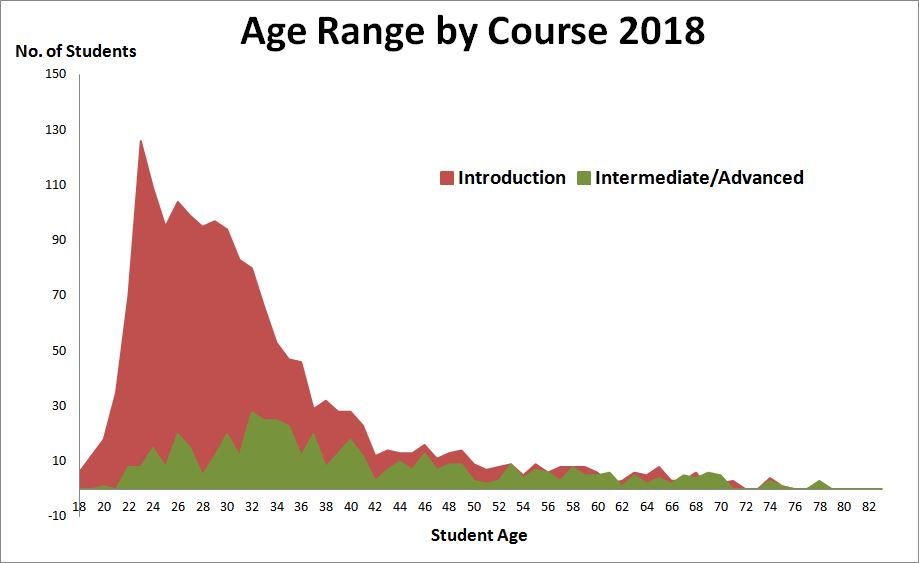
How many Men & Women take part in our courses (2018)?
Upcoming Events
- Building Inner Strength on July 27, 2024
- Guided Meditation on July 29, 2024 9:00 am
- Movie Day on July 29, 2024 2:00 pm
- Introduction to Buddhism on July 30, 2024
- Introduction to Buddhism on August 13, 2024
- Guru Puja on August 14, 2024 6:30 pm
- Introduction to Buddhism on August 31, 2024
- HH the Dalai Lama teaches locally! on September 6, 2024
- Introduction to Buddhism on September 17, 2024
- Less Desire, Less Pain – The Art of Satisfaction on October 5, 2024
About Tushita
Tushita is a centre for the study and practice of Buddhism from the Tibetan Mahayana tradition. We're located in Northern India, in the forested hills above the town of McLeod Ganj, Dharamsala - the seat in exile of His Holiness the 14th Dalai Lama.
Tushita aims to provide a friendly and conducive environment for people of all nationalities and backgrounds to learn about and put into practice the teachings of the Buddha. With this in mind we offer regular drop-in events and courses on introductory Buddhist philosophy and meditation, as well as intermediate level courses and group retreats for more experienced students.
Opening Hours
February to November
Monday - Saturday
9:30 - 11:30am
a break for lunch and then...
12:30 - 4:00pm
Closed Sundays


